Garden Glimpses: Farewell Summer!
As August waxes, the garden wanes. With the entrenched heat and increased drought, the riot of color that was early summer and July fades to straw and dun tones as Lammas passes, and only pockets of vibrancy remain to remind one of the garden’s heyday. I used to trim back spent or dying vegetation quicky, but I’m eco-systemically “woke” now, and realize that lots of critters depend on this garden detritus for their winter shelter, so I (try to) embrace the bleak, apocalyptic landscape emerging. (Well, it’ll be good for Hallowe’en, right?) Many early autumn bloomers are still budded, but some are starting to reveal their beauty, and a few summer stragglers fight bravely on.

Among the latter are my daylilies, which are well past peak but still sport a few dazzling blooms capping withered stems, on some varieties. I can’t complain – these started their season on June 1st this year, and the last bud opened August 29th, for a full three months of show. What more can one ask?

Queen Anne’s lace is also past peak, with its pancake blossoms furled like so many superfluous umbrellas on a sunny day. But there are stragglers here, too, late germinators who still thrust white platters of bloom to brighten the garden. And the infamous pokeberries have finally ripened to their purple-black glory, providing bunches of delectable fruit for birds (and a whole new crop of pokeberries where I don’t want them, next year).
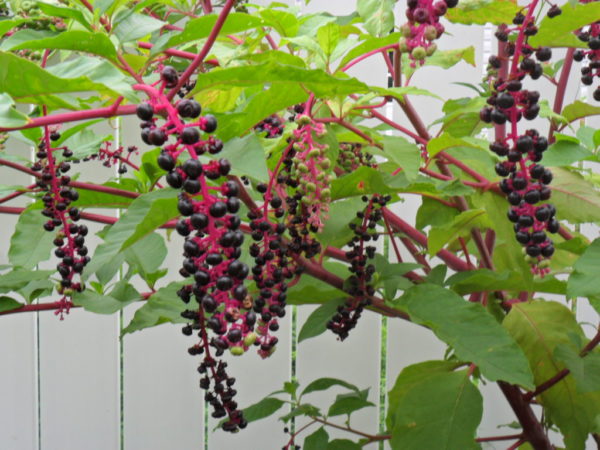
August began colorfully, with a flourish of the later-blooming Asiatic lilies, Stargazer and Tiger. This was the second year for Stargazer, deepest pink with darker freckles and a white trim, and all three plants bloomed voluminously (whereas only one flowered in the first year), though they didn’t spread. Not so for my heirloom Tiger lily, inherited from my parents, which broke the bounds of its foundation planting bed to encroach into the new wider expanse I created in 2019. I learned from last year’s flopping stalks, with flowers grazing the ground, that these Tigers need support, so I added a few hoops to the grouping when they were just knee high, and was rewarded with erect stems capped with deep orange, brown-spotted beauties, which held their blooms aloft throughout the season.
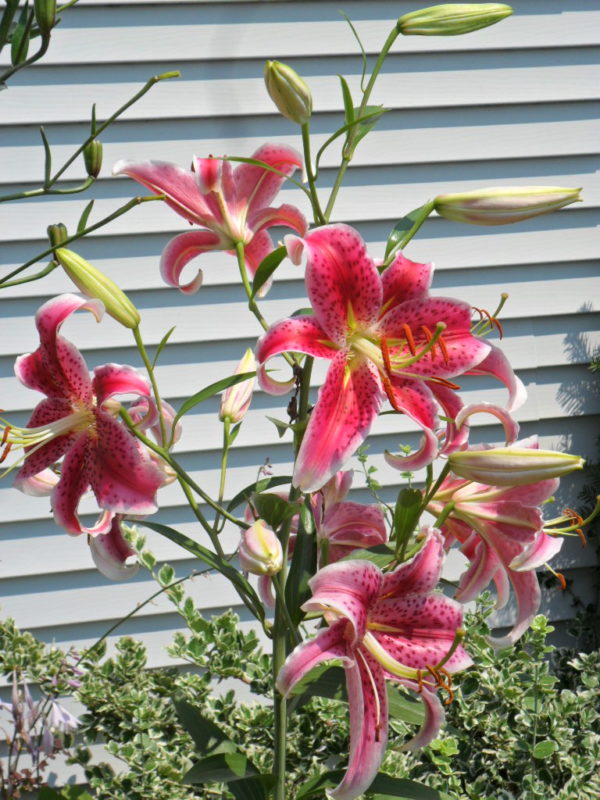
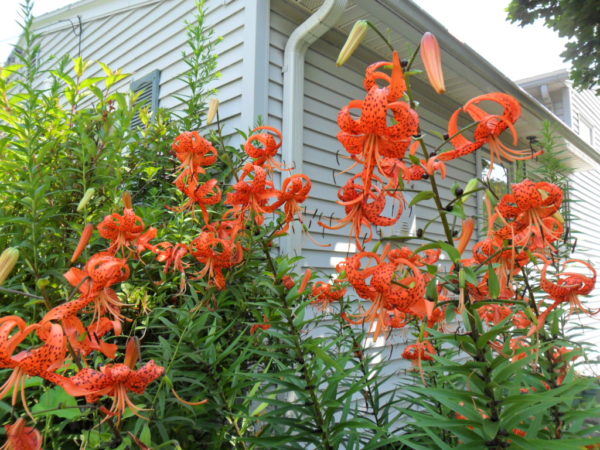
Also at peak then was my new Asclepius, commonly known as butterfly weed. I already had several yellow varieties, now in their second year, which bloomed earlier in July, but I treated myself to a lovely orange cultivar for my birthday. It was rather overpriced, but large and fully budded, just beginning to break, and I enjoyed its flowers for about two weeks before they faded and formed their strange alien-looking pods, which will split in due course to release fluffy seeds borne on dry breezes, hopefully populating other corners of my garden next year.

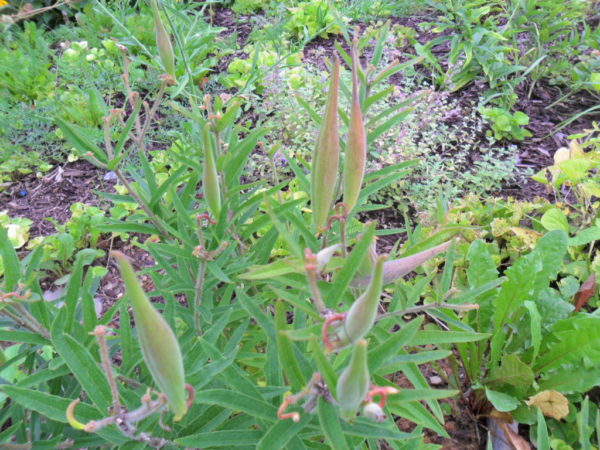
Blooming summerlong and until frost is Calamint, a low bushy perennial which sends thickly budded spikes about a foot high, studded top to bottom with delicate white flowers. It takes Calamint awhile to get up to speed, but once it starts blooming, it never stops. Drought tolerant and doing well in poor soil, as well as being another pollinator favorite, Calamint is a triple threat in the late summer and autumn garden.

By late August there’s been decent rebloom on some of the many coreopsis varieties, as well as blue daisy, and brilliant red Cardinal plant’s elongated blossoms are still blooming gradually, bottom to top, continuing to entice hummingbirds to refuel before their long migration begins in September. While most of the rudbeckia cultivars that dominated early summer are browned, skeletal husks by now, the species Brown-eyed Susans are still gorgeously vibrant, glowing brightly from half a dozen spots in the yard. And even those that have passed already have seeded descendants, just small bushy green mounds at present, but which may yet come to flower before a killing frost takes them, most likely in November.
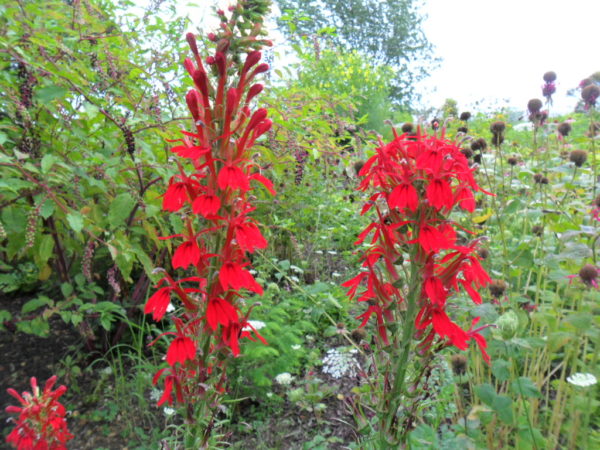

Another late summer bloomer is helenium, of which I have two varieties, one more red-orange with yellow striping and brown button centers, the other burgundy-brick with yellow trim and a less compact center. Helenium are long-lasting, drought tolerant and tough as nails; though their colors do fade after a time, their cheerful blossoms are a welcome sight in an otherwise sparse landscape.


Sedum is a classic late summer/early autumn garden plant, and I invested in several new varieties this spring, some of which are starting to open. Last year I contented myself with two standard “Autumn Joy” cultivars (ubiquitous with landscapers), moderately tall at 15”, with broad, flat heads of medium-pink, tiny starlike flowers. But this year I branched out into more exotic offerings, lower-growing versions, from groundcovers to some reaching perhaps 8” in height.

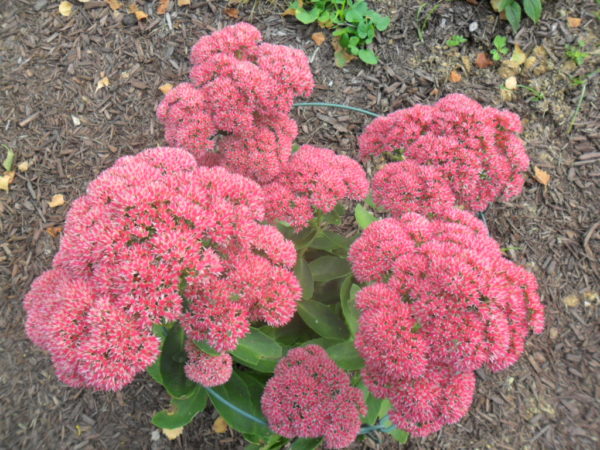
“Touchdown Teak” is my new favorite, with chocolate-brown foliage and snazzy two-toned blossoms, composed of a five-petaled rich rose-red frill, bulls-eyed with brilliant yellow stamens. Eye-popping, for sure! “Bertram Anderson” is similar in hue, but with its foliage inclining purplish-brown, and no showy center. “Boogie Woogie” is a low ground cover sedum, which I bought for its dramatic foliage, medium grey-green bordered with yellow, but also sports a bright yellow flower, blooming in mid-August. These have all done well for their first season, and in time will doubtless expand to fill the spaces allotted. They’re just beginning to open as we flip the calendar from August to September.
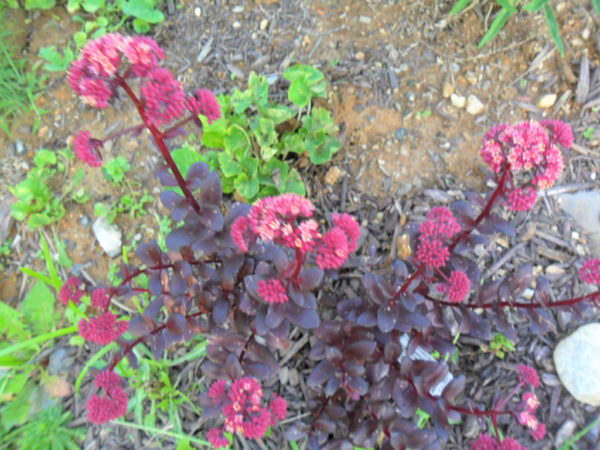
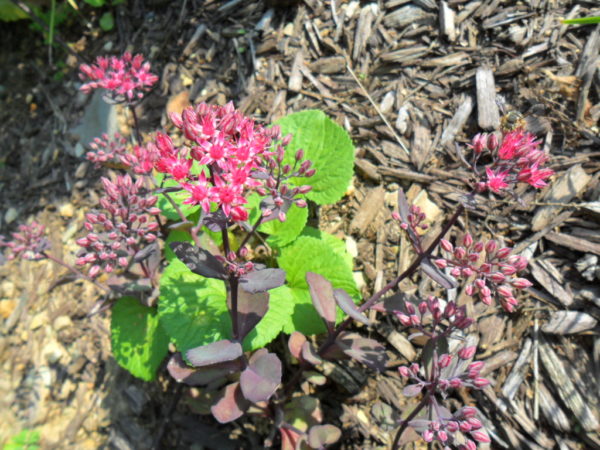

The incredible Maximillian Sunflower, now in its second year, surprised me by starting its bloom cycle a full month earlier than in its premiere season (a common occurrence for repatriated plants, which often bloom earlier or later than normal in their first year, as they adjust to local conditions). A rare perennial sunflower, Maximillian dies back to the soil in the late fall, but returns every spring to form a huge shrublike mass six feet tall and almost as wide, covered in clusters of medium yellow daisy-like flowers, about an inch and a half to two inches in diameter. Not your typical sunflower in appearance, pollinators adore it, and it’s one of a very few garden residents that continues to attract the almost-extinct honeybee to my yard. Those late July blooms were just harbingers of things to come, however, and Maximillian is now coming into its own, still loaded with hundreds of buds yet to unfurl.

In the shade garden, of course, blooms are few and far between at the best of times, but late August it’s the turn of Toad Lily to shine. This lovely green-and-yellow spear-leafed beauty sends delicate multi-branched stems above the foliage, bearing flowers colored purple and white, resembling an orchid. It has expanded quite a bit in its second year, and has a long bloom time of several weeks, with buds opening randomly, each lasting several days.

I’ve also been pleased by the showy quality of my garlic chives. These flat-leafed, wide-bladed cousins of culinary chives can also be used in cooking, but their flowers, unlike the pinky-purple puffballs of the standard variety, are splayed out in horizontal disks of teeny starlike blossoms, dazzlingly white, atop extended spikes that sway up to a foot above the foliage. The traditional chive blooms in June, but these late-August performers help to fill the gap in floral splendor, and provide a tasty treat as well. Their dried blossoms also work well in arrangements.

A plant which was a total surprise to me, and which took me years to identify, is St John’s wort. This volunteer first appeared on the top of the sand mound three years ago, and behaved so strangely that I had no idea what I was dealing with. That first season the plant was just a stick figure, about 8” tall, with two or three side branches, but it put out a raft of small bright golden flowers in midsummer which I found very attractive, and it had a fairly woody, sturdy stem, leading me to suspect it might be perennial, so I let it be. It had come up in the middle of a grassy area, which I later determined should be another planting bed, but in the meantime the risk of weed-whacking it to kingdom come was very real, so I tagged it with a bamboo skewer stuck into the ground beside it, and let it thrive.


It came back in year two, but as a low, spreading carpet, almost a ground cover, not more than 4” high, and filled out to a diameter of about a foot. I’d have never guessed it was the same plant, except it was in the same place, and it later bore the same flowers. Intrigued, I let it be again, and this year was rewarded with a large bushy plant, two feet high and about as wide, covered in yellow blooms all season. Most profuse in late June and early July, it continues to produce thinly scattered blossoms, and like the Maximillian sunflower, is a pollinator magnet. I suspected it was St John’s wort, based on an Internet search, but wasn’t certain until a friend confirmed that just a few weeks ago. Botanically known as hypericum, the plant has a variety of medicinal and ceremonial uses, including as an antidepressant, and yields a red dye resembling blood when its petals are crushed or steeped. How it got here, I have no idea! I have never seen it in the wild locally.
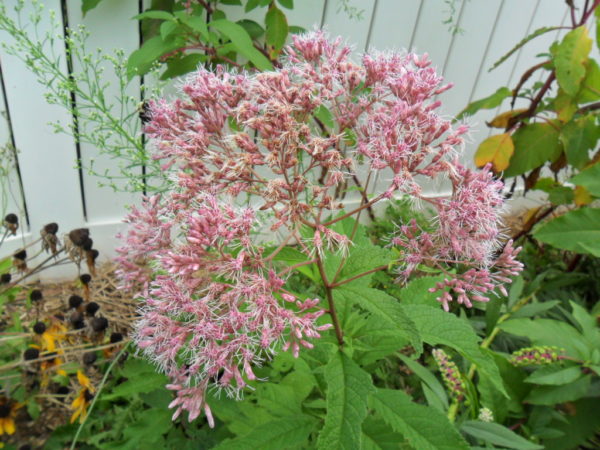
Joe Pye Weed is another new arrival, and one I’ve coveted for some time. A late bloomer, Joe Pye can grow its sturdy stalks as much as 8 feet or more, and in late August into September they are topped with rosy pink masses of small-flowered bloom heads, somewhat fuzzy in appearance. It makes a dramatic statement, and I intentionally placed one just inside the garden gate for that purpose. But alas! I fear I may have inadvertently bought a dwarf form! I had two standards in my hand at a local native plant nursery, but as I browsed their collection, I noted another variety that was billed as having a sweet scent and better drought tolerance, so I switched them up for the standards, never checking the size specifications.
When these began to set buds at just four feet, I began to doubt my choice. Hopefully it’s just a byproduct of their youth, and in time they’ll grow to full height, but I think I need to search through my basket of plant tags to see if I can identify the precise cultivar and research it.

We’re still weeks away from major bloom on the fall wildflowers: stiff aster, frost aster, large leaf aster, Michaelmas daisy, and white snakeroot, but some of the wild goldenrod has started to burst into masses of deep yellow clusters, fairly glowing in the garden. These natives are well adapted to local conditions, and have to be sternly reprimanded with the shovel and secateurs, lest they take over completely. But when well-managed, they form huge clumps of vegetation that extend the bloom season well into November, when most cultivated plants have long gone, and also provide vertical interest for the winter, with many varieties ranging to six feet in height or above.
Only three of the six “hardy” chrysanthemums I planted last year have returned, but they are doing well, thickly budded, awaiting their turn to bloom in a few weeks. Offhand I can’t recall which colors I planted where, but I’m looking forward to being pleasantly surprised.
Late summer can be a rather dreary time in the garden, but there are still islands of color to entice the eye, and the promise of autumn colors to come, when not only perennials, but the very structural bones of the garden itself, shrubs and trees, round out the growing season with a blaze of glorious hues!


4 comments, add yours.
anne
Hi Alex, always love your garden posts! At the risk of sounding like a know it all, I am wondering if your Maximilian sunflower isn’t instead Sunflower Lemon Queen? I grow both and even though the Maximilian does not do well in northern Vermont, it seems to me it is more golden yellow, and the blossoms are up and down the stems. Or may be it’s the photo?
Alex Miller
Authoryou appear to be correct! further research suggest that I was, indeed, sent the wrong bareroot stock when I ordered my Maximillian Sunflower. well, to mangle Shakespeare, a sunflower by any other name! I like what I have!
Esperanza Acosta
Gracias por este regalo
Laurien
So lovely, Alex! I am really fond of Stargazer lilies so appreciated the photo of them. Also loved the perennial sunflower and must see if they grow in my area. I’m so glad you think about the insects and other critters in your garden. Will look forward to your fall garden post! Thank you for sharing!